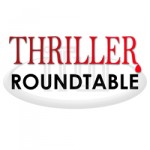

October 22 – 28: Horror: “What is essential to crafting a believable horror environment?”
 It’s time for halloween: ghosts, goblins, jack-o-lanterns and horror writers! We have a packed house this week with ITW’s premier horror authors. This week join David Sakmyster, Brett Talley, M.R. Gott, Michaelbrent Collings, R. Thomas Riley, W.D. Gagliani, Rick Reed, JG Faherty, Douglas Wynne and Christian Riley as they discuss the essentials of crafting a believable horror environment.
It’s time for halloween: ghosts, goblins, jack-o-lanterns and horror writers! We have a packed house this week with ITW’s premier horror authors. This week join David Sakmyster, Brett Talley, M.R. Gott, Michaelbrent Collings, R. Thomas Riley, W.D. Gagliani, Rick Reed, JG Faherty, Douglas Wynne and Christian Riley as they discuss the essentials of crafting a believable horror environment.
~~~~~
 R. Thomas Riley is the author of the short story collection THE MONSTER WITHIN IDEA (2009-2011) published by Hugo Nominated Apex Publications and re-released as a Kindle exclusive in 2011. IF GOD DOESN’T SHOW (co-written with John Grover) was published by Permuted Press and Audible.com, July 2012. DIAPHANOUS (co-written with Roy C. Booth) is available now. THE DAY LUFBERRY WON IT ALL was adapted to short film by Frosty Moon Omnimedia in 2010.
R. Thomas Riley is the author of the short story collection THE MONSTER WITHIN IDEA (2009-2011) published by Hugo Nominated Apex Publications and re-released as a Kindle exclusive in 2011. IF GOD DOESN’T SHOW (co-written with John Grover) was published by Permuted Press and Audible.com, July 2012. DIAPHANOUS (co-written with Roy C. Booth) is available now. THE DAY LUFBERRY WON IT ALL was adapted to short film by Frosty Moon Omnimedia in 2010.
 Douglas Wynne is no stranger to dark places; he honed his storytelling craft as a frontman in basements and bars during Boston’s 90′s‐era underground rock scene. Originally from Long Island, he attended Berklee College of Music, followed by a stint as a recording engineer in Woodstock, New York before returning to Massachusetts, where he currently resides with his wife and son. THE DEVIL OF ECHO LAKE is his first novel.
Douglas Wynne is no stranger to dark places; he honed his storytelling craft as a frontman in basements and bars during Boston’s 90′s‐era underground rock scene. Originally from Long Island, he attended Berklee College of Music, followed by a stint as a recording engineer in Woodstock, New York before returning to Massachusetts, where he currently resides with his wife and son. THE DEVIL OF ECHO LAKE is his first novel.
 With forty story acceptances in less than two years, as well as a recent “Honorable Mention” at L. Ron Hubbard’s Writers of the Future Contest, Christian Riley sees no end to his addiction to writing. His stories have been published in numerous magazines and anthologies, including Midwest Literary Magazine, Short Story.Me, Bete Noire, The Absent Willow Review, Underground Voices, Residential Aliens, Bards and Sages Quarterly, and the widely acclaimed anthology from The Horror Zine, A Feast of Frights. You can reach him at chakalives@gmail.com, or at his rather static blog; frombehindthebluedoor.wordpress.com
With forty story acceptances in less than two years, as well as a recent “Honorable Mention” at L. Ron Hubbard’s Writers of the Future Contest, Christian Riley sees no end to his addiction to writing. His stories have been published in numerous magazines and anthologies, including Midwest Literary Magazine, Short Story.Me, Bete Noire, The Absent Willow Review, Underground Voices, Residential Aliens, Bards and Sages Quarterly, and the widely acclaimed anthology from The Horror Zine, A Feast of Frights. You can reach him at chakalives@gmail.com, or at his rather static blog; frombehindthebluedoor.wordpress.com
 David Sakmyster’s stories, screenplays and novels cross a range of genres and include the supernatural thriller Blindspots, the horrifying Crescent Lake, the historical epic, Silver and Gold, and The Morpheus Initiative – a series about psychic archaeologists (including The Pharos Objective, The Mongol Objective and The Cydonia Objective). With author Steven Savile, he’s co-writing a thrilling series about near death experiences called The Lazarus Initiative, and his screenplay, Nightwatchers, has just been optioned.
David Sakmyster’s stories, screenplays and novels cross a range of genres and include the supernatural thriller Blindspots, the horrifying Crescent Lake, the historical epic, Silver and Gold, and The Morpheus Initiative – a series about psychic archaeologists (including The Pharos Objective, The Mongol Objective and The Cydonia Objective). With author Steven Savile, he’s co-writing a thrilling series about near death experiences called The Lazarus Initiative, and his screenplay, Nightwatchers, has just been optioned.
 Brett J. Talley is the Bram Stoker Nominated author of That Which Should Not Be and The Void. A native of the South, Brett received a philosophy and history degree from the University of Alabama before moving to witch-haunted Massachusetts to attend Harvard Law School. He seeks out the mysterious and the unknown and believes that the light can always triumph over the darkness, no matter how black the night may be.
Brett J. Talley is the Bram Stoker Nominated author of That Which Should Not Be and The Void. A native of the South, Brett received a philosophy and history degree from the University of Alabama before moving to witch-haunted Massachusetts to attend Harvard Law School. He seeks out the mysterious and the unknown and believes that the light can always triumph over the darkness, no matter how black the night may be.
 M.R. Gott, the author of the novel WHERE THE DEAD FEAR TO TREAD which was called ” frantic, horrific, brutal, and without doubt the darkest thing I have read in years. Maybe in my life, by She Never Slept and “one of the most disturbing and atmospheric things I’ve read in a long while,” by Dana Fredsti author of Plague Town. Aside from writing, M.R. enjoys strong coffee, dark beer, red wine, and fading light.
M.R. Gott, the author of the novel WHERE THE DEAD FEAR TO TREAD which was called ” frantic, horrific, brutal, and without doubt the darkest thing I have read in years. Maybe in my life, by She Never Slept and “one of the most disturbing and atmospheric things I’ve read in a long while,” by Dana Fredsti author of Plague Town. Aside from writing, M.R. enjoys strong coffee, dark beer, red wine, and fading light.
 Michaelbrent Collings is a bestselling novelist and produced screenwriter. His last two horror novels, APPARITION and THE HAUNTED, have spent months on Amazon’s horror and supernatural horror bestseller lists; and BARRICADE, for which he wrote the screenplay, was released on DVD/BluRay throughout North America in September of 2012. He hopes someday to develop superpowers, or at the very least a cool robot arm. You can follow him on Facebook and in so doing you will guarantee your safety when the Glorious Revolution/Zombie Apocalypse/Fall of Western Civilization begins.
Michaelbrent Collings is a bestselling novelist and produced screenwriter. His last two horror novels, APPARITION and THE HAUNTED, have spent months on Amazon’s horror and supernatural horror bestseller lists; and BARRICADE, for which he wrote the screenplay, was released on DVD/BluRay throughout North America in September of 2012. He hopes someday to develop superpowers, or at the very least a cool robot arm. You can follow him on Facebook and in so doing you will guarantee your safety when the Glorious Revolution/Zombie Apocalypse/Fall of Western Civilization begins.
 W.D. Gagliani is the author of the horror thriller WOLF’S TRAP (Samhain Publishing), a past Bram Stoker Award nominee, as well as WOLF’S GAMBIT and WOLF’S BLUFF (47North), WOLF’S EDGE (Samhain), the upcoming WOLF’S CUT (Samhain), the hard-noir thriller SAVAGE NIGHTS (Tarkus Press), the collection SHADOWPLAYS, as well as MYSTERIES & MAYHEM (Tarkus Press, w/ David Benton). Gagliani is also the author of various short stories published in many anthologies, plus numerous book reviews, articles, and interviews. He is an Active member of the Horror Writers Association (HWA), the International Thriller Writers (ITW), and the Authors Guild. He lives and writes in Milwaukee, Wisconsin. Find him on Facebook and Twitter.
W.D. Gagliani is the author of the horror thriller WOLF’S TRAP (Samhain Publishing), a past Bram Stoker Award nominee, as well as WOLF’S GAMBIT and WOLF’S BLUFF (47North), WOLF’S EDGE (Samhain), the upcoming WOLF’S CUT (Samhain), the hard-noir thriller SAVAGE NIGHTS (Tarkus Press), the collection SHADOWPLAYS, as well as MYSTERIES & MAYHEM (Tarkus Press, w/ David Benton). Gagliani is also the author of various short stories published in many anthologies, plus numerous book reviews, articles, and interviews. He is an Active member of the Horror Writers Association (HWA), the International Thriller Writers (ITW), and the Authors Guild. He lives and writes in Milwaukee, Wisconsin. Find him on Facebook and Twitter.
 Rick R. Reed is the author of dozens of published novels, novellas, and short stories. He is a two-time EPIC eBook Award winner. His work has caught the attention of Unzipped magazine, “The Stephen King of gay horror,”; Lambda Literary, “A writer that doesn’t disappoint,”; and Dark Scribe magazine, “an established brand—perhaps the most reliable contemporary author for thrillers that cross over between the gay fiction market and speculative fiction.” He lives in Seattle. To learn more about Rick and his various titles, please visit his website and his blog.
Rick R. Reed is the author of dozens of published novels, novellas, and short stories. He is a two-time EPIC eBook Award winner. His work has caught the attention of Unzipped magazine, “The Stephen King of gay horror,”; Lambda Literary, “A writer that doesn’t disappoint,”; and Dark Scribe magazine, “an established brand—perhaps the most reliable contemporary author for thrillers that cross over between the gay fiction market and speculative fiction.” He lives in Seattle. To learn more about Rick and his various titles, please visit his website and his blog.
 A lifelong resident of New York’s highly haunted Hudson Valley region, JG Faherty grew up amid Revolutionary War graveyards, haunted roads, and woods filled with ghostly apparitions. His varied professional career includes working as a resume writer, laboratory manager, accident scene photographer, zoo keeper, scientist, and salesman. He began writing fiction in 2001, and his short stories, poetry, and articles- have appeared in numerous magazines and anthologies.
A lifelong resident of New York’s highly haunted Hudson Valley region, JG Faherty grew up amid Revolutionary War graveyards, haunted roads, and woods filled with ghostly apparitions. His varied professional career includes working as a resume writer, laboratory manager, accident scene photographer, zoo keeper, scientist, and salesman. He began writing fiction in 2001, and his short stories, poetry, and articles- have appeared in numerous magazines and anthologies.
- LAST GIRL MISSING with K.L. Murphy - July 25, 2024
- CHILD OF DUST with Yigal Zur - July 25, 2024
- THE RAVENWOOD CONSPIRACY with Michael Siverling - July 19, 2024
